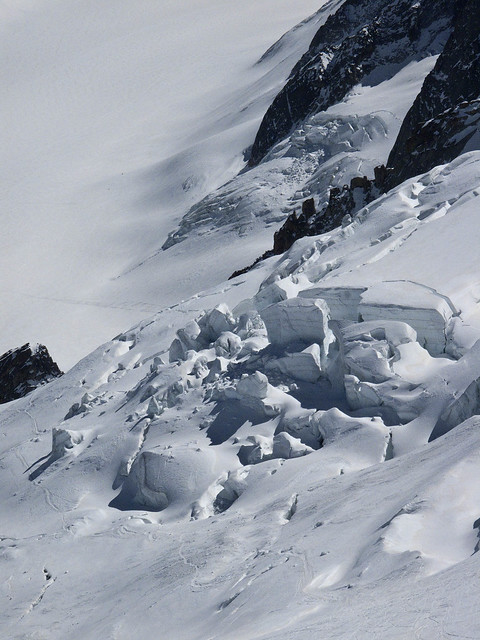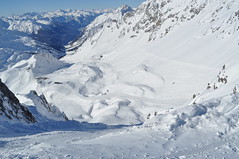The boy was skiing with his father and his twin brother and a local ski guide. They started an avalanche which carried one of the boys, his father and the guide down the mountain around 150 metres. Fortunately the local news (understandably) provided a bit more detail: "Bereich Madloch-Fauler Stock Richtung Stierlochbach" and a photo of the avalanche.
The area NW of Madlochjoch on OpenSnowMap (View Larger Map)
(close the overlay to see the map)
(close the overlay to see the map)
The whole Arlberg area is well-known for a plethora of named off-piste ski routes, to quote "... every variant, however rarely skiable has a name...", so there was a good chance that this accident happened on a well-known run: particularly as it was so early in the season. As the avalanche debris fan was next to some Pinus mugo scrub the number of locations could be reduced. I own two books on Arlberg off-piste routes, but neither was to hand. I did find this fine photo with the main itineraries marked:
 |
| Overview of off piste routes accessible from Madlochjoch ((c) Author: Roland Wasmayer, Source: freeskiers.net via OutdoorActive) |
I mapped a little bit of the scrub on OpenStreetMap and also found this image of the entry to the Stierfall route. I suspect the the accident happened in either Heuwet or Heuwetrinne: both so frequently skied in mid-season to be heavily mogulled. None of these itineraries are mapped on OpenStreetMap, as is true for other itineraries throughout the Arlberg ski area.
 |
| Entering the Stierfall, photo Stegaku |
One of the odd things about this is to discover long vanished ski lifts. A post on Edward Tufte's forum alerted me to a website featuring Heinrich Berann's ski maps and panoramas. (Berann may be familiar to others as the illustrator / cartographer of Ocean Floor maps). Berann's style is very recognisable.
 |
| Ski map of St Anton-am-Arlberg by Prof H.C. Brann |
What is particularly interesting is that he made ski 'maps' for the Arlberg area from 1937 through to the late 1970s, and therefore it is possible to trace some of the evolution of the area's infrastructure. Most noticeable is that until around 1980 there was a lift on the W side of the Arlberg road at St Christoph. Also noticeable is the curious way the grading of ski runs has changed: particularly true of runs now classed as freeride. Runs which were once just graded as black turned into ski itineraries, and some have just disappeared.
Of course someone has thought of mapping freeride territory: Freeridemaps of Altstätten, Switzerland. The sample image on their website is the Arlberg area around St Anton-am-Arlberg. In the main the map shows areas appropriateness for different ranges of skill and experience: but as far as I can tell largely based on objective factors, such as safety of run-outs, and likely consequences of a fall. Above all it is based on the steepness of the land.
The Swiss and Austrian avalanche service also produce map overlays based on steepness to show avalanche risk: in the Swiss case this data is available by subscription in the White Risk app for Android and the iPhone.
Mapping avalanche risk on it's own is a challenge. There are numerous different factors to represent: altitude, age and depth of snow pack, recent changes to snow pack, aspect, underlying terrain (steep grass slopes often avalanche). In writing this post I came across some interesting papers on the subject of the cartography of avalanche maps.
| Profile of Snowpack derived using DAVOS ELF SNOWPACK program |
Despite the great advances made in the past year with OpenSnowMap there is considerably more which we could do to provide information relevant to freeride and back-country skiing, and ski mountaineering.
- Grading. In my view the current use of a single category of freeride downhill routes is misleading, Many off-piste guides such as those for the major French resorts published by Editions Vamos, or the similar Polvere Rosa covering the south side of the Monte Rosa massif, make use of grading schemes (4 classes of technical difficult in the former, 7 in the latter which includes some extreme itineraries; and 4 classes of objective dangers). I am hesitant to mark freeride areas which I know because of the wide range of difficulties and objective dangers likely to be encountered.
- Routes. To a certain extent showing routes spoils some of the key aspects of being away from the piste. Picking ones own line, both in the light of one's ability and safety of surroundings is part and parcel of developing the skills and awareness necessary. In many places (Albona at Stuben, most of Les Grands Montets below 2800m, Pavi in A-basin) all that is needed is to show that the area is free-ride territory. In others entry lines and exit routes may not be immediately obvious and are worth showing (it is not uncommon for these to be the least pleasant part of a route), particularly if there are cliffs or other hazards lower down (e.g., above Le Fornet, Val d'Isere).

Seracs on Glacier des Rognons, Les Grand Montets by LensScaper, on Flickr
IGN Geoportail shows what's underneath the snow.
- Objective Hazards. If more freeride terrain is to be added to OpenStreetMap there needs to be much more mapping of the obvious objective hazards: cliffs as mentioned above are the prime example. Others might include: streams (which may not be frozen enough to bear loads), known crevasse and serac fields (mapping individual crevasses can wait a while), 'bullet-proof' ice on glaciers, and notorious avalanche gullies.
- Safety. Obviously marking ski routes creates some concerns over people placing too much reliance on such information. In reality people undertaking such routes require a minimum level of skill, equipment, knowledge and experience.
Note: This post contains a number of images which are copyright by their respective authors, and are not licensed under creative commons. Normally I try and only use CC images, but in this case suitable images were not available. Please respect the rights of the image owners.



